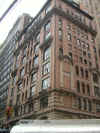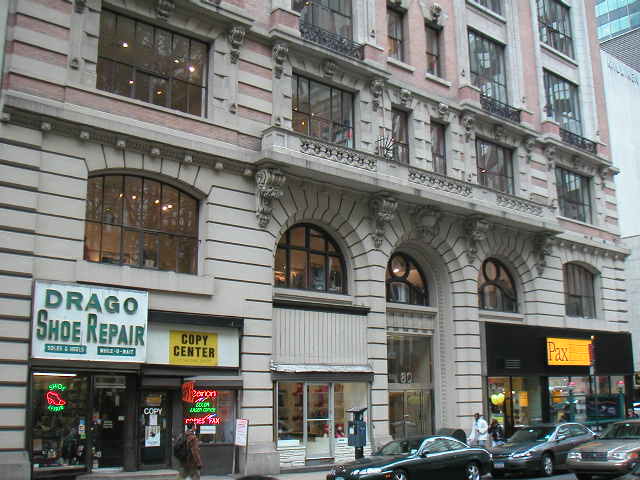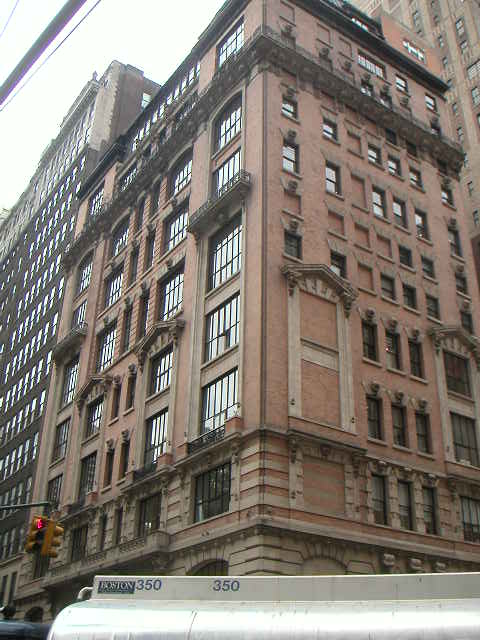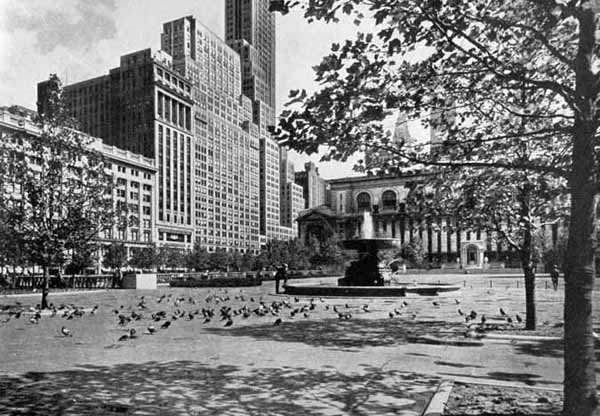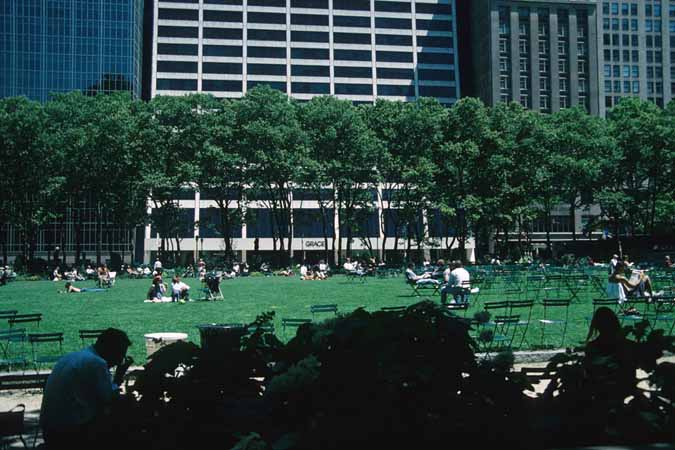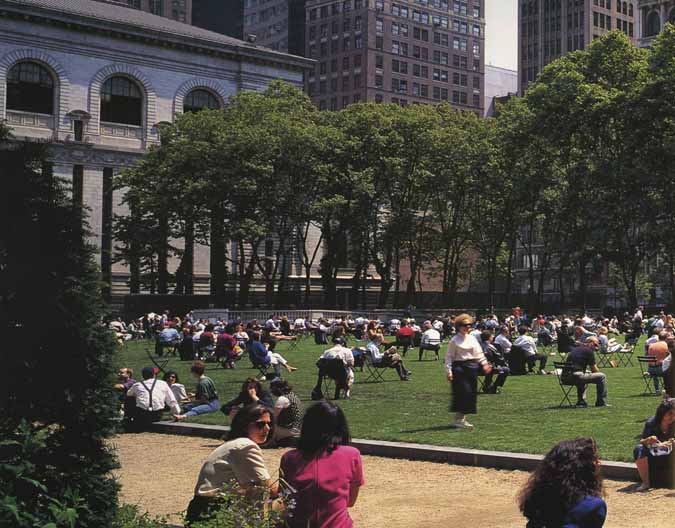|
notes
|
|
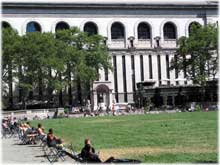 Bryant
park, an 8 acre large green oasis at the
intersection of 42nd Street and Sixth Avenue is one
of the most pleasant parks in Manhattan. Even though
the park is bordered by heavily trafficked streets,
it is a very relaxing park. It has a simple but
effective design, with a large, central lawn
surrounded by trees. Bryant
park, an 8 acre large green oasis at the
intersection of 42nd Street and Sixth Avenue is one
of the most pleasant parks in Manhattan. Even though
the park is bordered by heavily trafficked streets,
it is a very relaxing park. It has a simple but
effective design, with a large, central lawn
surrounded by trees.
From the park you have a great view on some great
architectural landmarks, including the former
American Radiator Building. Similar to some Parisian
parks like the
Jardin du Luxembourg, you can take one of the
2,000 available chairs and sit wherever you prefer.
The history of the Bryant Park starts in the 19th
century, when it was known as Reservoir square. It
was named after the Croton reservoir that was
constructed adjacent to the square in 1842. In 1853
the first American World Exposition was held here in
the Crystal Palace, a magnificent glass
construction. Five years later, the palace was
destroyed by fire. In 1884 the square was renamed
Bryant Park after 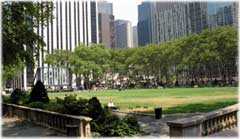 William
Cullen Bryant, a poet and lawyer. He was one of the
most influential advocates for abolition of slavery
in the United States and one of the forces behind
the creation of
Central Park. William
Cullen Bryant, a poet and lawyer. He was one of the
most influential advocates for abolition of slavery
in the United States and one of the forces behind
the creation of
Central Park.
In 1899 the Reservoir adjacent to Bryant Park was
demolished replaced by the New York Public Library.
As part of this construction which would last until
1911, terraces and kiosks were constructed at the
park.
After several decades of neglect, the park was
redesigned between 1933 and 1934 as part of the
depression-era public works project. The competition
winning design by Lusby Simpson was implemented by
Robert Moses. It featured a great lawn and hedges
which obscured the views from the surrounding
streets. Two years later, an iron fence was
constructed around the park. This design resulted in
a public space virtually cut off from the
surrounding city life. You could pass the park
unaware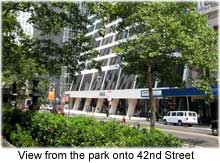 of the activities within. This made it appealing for
drug addicts and in the seventies and eighties, the
park was shunned by most citizens and tourists.
of the activities within. This made it appealing for
drug addicts and in the seventies and eighties, the
park was shunned by most citizens and tourists.
In the 1970s the Bryant Park Restoration Corporation
was founded by the Rockefeller Brothers. This led to
a privately funded redesign and restoration 1988.
The redesign by landscaper architect Hanna/Olin and
garden designer Lynden B. Miller was aimed towards
restoring activity in the park. The high hedges were
replaced by shrubs opening the park up to the
streets. In 1992, the new Bryant Park was officially
opened and became an instant success. It is now one
of New York's most popular parks. In 2002 the park
became the city's first 'wireless park', which means
you can connect to the internet with a 802.11b
Ethernet card.
The park contains five statues plus the Josephine
Shaw Lowell fountain. Built in 1912 and designed by
Charles Adams Platt, this was the first monument 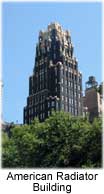 dedicated
to a woman. Lowell (1843-1905) was a pioneering
social reformer. In 2002 a carousel was added to the
park. dedicated
to a woman. Lowell (1843-1905) was a pioneering
social reformer. In 2002 a carousel was added to the
park.
Bryant Park is hemmed in by some great landmarks. On
the east side of the park is the 1911 New
York Public Library. The magnificent
Beaux-Arts building was designed by Carrere &
Hastings. The collection contains more than 7
million books. The library's entrance is at Fifth
Avenue, from the Bryant Park you look onto the back
side of the building.
Another building of interest is the former
American Radiator building, a great 1924
skyscraper in neo-Gothic style with Art Deco
ornaments. The 22 story 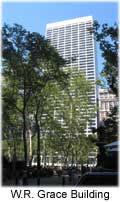 tower
was designed by André Fouilhoux and Raymond Hood;
the latter is also known for the
Tribune Tower in Chicago. tower
was designed by André Fouilhoux and Raymond Hood;
the latter is also known for the
Tribune Tower in Chicago.
Another landmark near the Bryant Park is the 1901
Bryant Park Studios, a building on 40th
street in Beaux-Arts style. On the other side of the
park is the more modern and larger W.R.
Grace building, a sleek 50 story building
designed by SOM's Gordon Bunshaft. It was
constructed in 1974 for the W.R. Grace chemical
company.
|
|
|
| Publication:The
New York Sun; |
Date:Jan
21, 2004; |
Section:Editorial
& Opinion; |
Page:8 |
|
|
The Fall and Rise of Bryant Park
By JULIA VITULLO-MARTIN Ms.
Vitullo-Martin is a senior fellow at the Manhattan Institute.
Shrewd developers often name their buildings for their
neighborhood’s most attractive asset. In this tradition, the Durst
Organization recently announced that it was conferring the address of
One Bryant Park on its flashy new Midtown tower, whose major tenant will
be the Bank of America. On an average day in good weather, lovely,
crime-free Bryant Park is wildly popular, drawing some 5,300 visitors at
midday, or 900 people an acre.It is almost surely the most used urban
open space in the world, exceeding even St. Mark’s in Venice. The New
York Times calls it “Manhattan’s town square.”
Yet associating any new building with Bryant Park would have been
unthinkable just 20 years ago — akin to naming a building One Needle
Park, which would pretty well summarize the drug den that was then
Bryant Park. I remember this well because the Citizens Housing and
Planning Council,my former employer, had offices on West 40th Street,
Bryant Park’s southern boundary. We had ringside seats for the sordid
dealing and using that went on openly in the park, nestled behind the
New York Public Library.
Entrepreneur Michael Fuchs, who was the first chairman of HBO, which
was headquartered across the park on West 42nd Street, also remembers
those days well. “It was the Wild West down there,” he recalled
recently. We had all come from uptown — Rockefeller Center, a good
neighborhood.The Bryant Park area was so bad that people had no reason
to go out.We developed a philosophy that we would make the HBO building
self-sufficient,with a great cafeteria, gym, screenings, whatever people
needed.”
In retrospect,it may be hard to grasp that city government actually
permitted the ongoing, daily degradation of such a magnificent asset.
After all,the city-owned Bryant Park wasn’t hidden in some obscure
corner, far away from official eyes. It’s been right there since the
mid-19th century. It sits squarely in the middle of Midtown, surrounded
by world-renowned landmarks. For example, the gorgeous Beaux-Arts New
York Public Library, which opened in 1911 and uses two acres of Bryant
Park,was designed by Carrère & Hastings. Raymond Hood’s 1924 neo-Gothic
American Radiator building, on West 40th Street, now the Bryant Park
Hotel, is regarded by many architects as the finest building in New
York.
The Beaux-Arts Bryant Park Studios Building, which opened in 1901,
was built for a New York artist who had just returned from
Paris,bringing with him the French emphasis on natural northern light.He
commissioned lavish double-height workshop/residential studios with huge
windows to capture the unobstructed light from Bryant Park.Yet in
1979,things were such a mess that the eminent urbanist,William
Whyte,wrote about Bryant Park, “If you went out and hired the dope
dealers,you couldn’t get a more villainous crew to show the urgency of
the situation.”
Bryant Park had 150 reported robberies and 10 rapes annually,
countless auto break-ins on the periphery, and a murder every other
year. As a public park it was so mismanaged that it held down the
property values of the surrounding neighborhood.
Today Bryant Park pumps up property values. Bank of America Senior
Vice President John Saclarides says about the new tower, “Because of
Bryant Park, we anticipate great employee happiness with our site. We
think our employees will use the park for visitation, for reading, and
for a remote office at lunch time.” (The park now has free wireless
fidelity Web access, known as “wi fi.”) What happened?
In 1980 a group of civic-minded New Yorkers, property owners, and
neighbors decided to rescue the park, and set up the Bryant Park
Restoration Corporation. They spent seven years negotiating with the New
York City Department of Parks and Recreation before they succeeded in
getting a 15-year lease, which began in 1988. (The lease was
subsequently renewed for another five years.) The BPRC immediately
closed the park for five years of rebuilding.
The old design — a formal French garden — had dated from 1934, when
Parks Commissioner Robert Moses, New York’s master of public works,
decided to elevate and isolate the park above the sidewalk. Instead of
making Bryant Park an elegant respite from the congestion of midtown as
intended,the isolationist design deterred desirable users while
attracting undesirable users.
The new BPRC design aimed to re-people the park while raising
revenues to pay for the expensive planned maintenance of several million
dollars annually — far more than the city spent. The designers cut new
entrances, tore down the iron fencing, ripped out high hedges, restored
the fixtures, and added neoclassical kiosks for concessions.
Fixed benches were replaced with some 3,200 movable, pretty French
chairs and 500 tables, providing what Mr. Biederman calls “freemarket
seating.” The park’s Upper Terrace, which had been its most active drug
market, was leased to the trendy Bryant Park Grill, which became an
instant hot spot.
High standards of behavior are enforced by the security
officers,whom Mr.Biederman calls “friendly but firm.”They deter “little
pieces of disorder,” as Mr. Biederman calls misdemeanors. The old
laissez-faire attitude toward disruptive behavior is gone. Neighboring
business people and property owners are overjoyed.
The chairman of Mountain Development Corporation, which owns the
now-landmarked Bryant Park Studios, Robert Lieb, recalled that crime was
so bad in 1980 that his building could only be marketed by promising
strong private security.“The park should have been a positive for us,
but the drug dealing and crime made it a negative,” he said.
Today,he says,his company doesn’t even have to work to rent
space.“Our tenants,boutique designers, and manufacturers who specialize
in sales to stores like Barney’s and Nordstrom’s, want to be on the
park.”Tenants include hip designers like Theory and Angel Zimick.
“Bryant Park proves that if you build something beautiful that
people can enjoy,”Mr.Lieb said. “They will pay a premium price to be
there.”And,indeed,rents soared to the mid-50s today from $14 a square
foot in 1980.
Perhaps best of all, taxpayers aren’t footing the bill for the
park’s $4 million annual budget, which is all privately raised.While $5
million of the $18 million spent on capital improvements came from
public funds, no public money has been spent on the park since 1996. It
may well be the only urban park in the world supported by neither
government nor charitable funds.
“Because this park is integral to the functioning of Midtown, we ask
commercial interests and users to pay for it,” Mr. Biederman said.
Bryant Park’s successful privatization is a tribute to a selfless
innovation by the public sector — permitting the private sector to step
in with resources and operational skills to restore and manage a
splendid public space.Most public officials wouldn’t have had the
courage to let the private sector take over.
New York taxpayers owe heartfelt thanks to the four mayors,
beginning with Edward Koch, and the four parks commissioners, finishing
with Adrian Benepe, who made this happen. |
|
|
This area was set aside as early as 1686
for public use; from 1823 to 1840, like many of Manhattan's parks, it
was used as a pauper's graveyard. In 1842, the Croton Reservoir was
built on the east side of the space, where the New York Public Library
is now, and the remaining land became known as Reservoir Square.
The Crystal Palace was built on the
site in 1853, a marvelous seven-story exhibition space made of glass and
cast iron that housed America's first world's fair before burning down
spectacularly on October 5, 1858.
After serving as a parade ground for Union
troops during the Civil War, Reservoir Square was designated a park in
1871, and was renamed in 1884 for
William Cullen Bryant, poet, lawyer, New York Post editor,
abolitionist and park advocate. It was not much of a park, though, until
it was landscaped in French garden style in the 1930s, the object of a
contest for unemployed architects.
By the 1970s, the park had become chiefly
known as a drug market, but since a re-landscaping in 1992 occasioned by
the creation of underground stacks for the library, it's become a highly
valued urban space. It's the venue for popular outdoor movies in the
summer.
Sculptures in the park include an imposing
Bryant, Goethe, Gertrude Stein, copper maganate and YMCA founder William
Dodge (by John Quincy Adams Ward; (originally in Herald Square) and
Brazilian liberator Jose de Andrada --not to mention Big Crinkly
by Alexander Calder.
|
